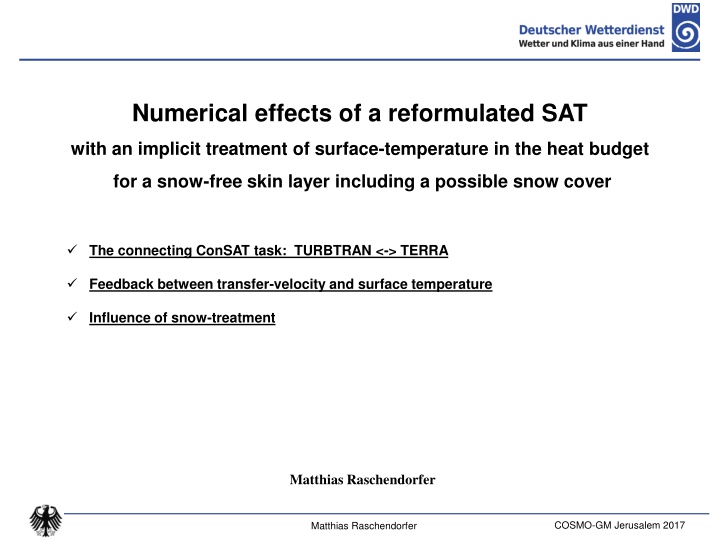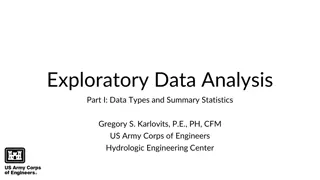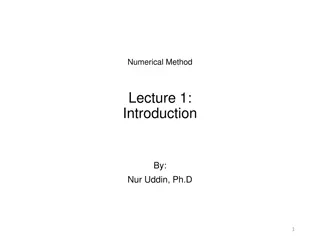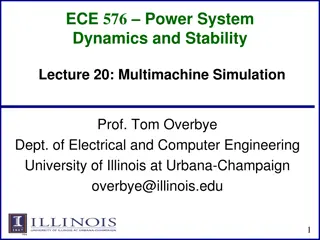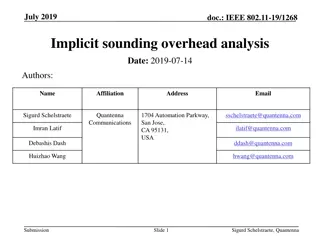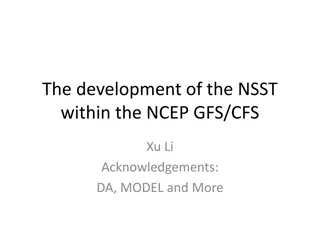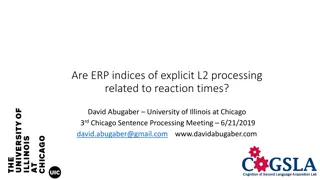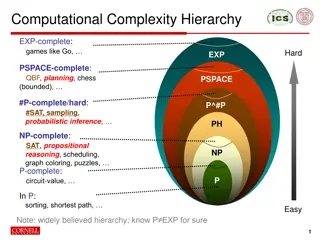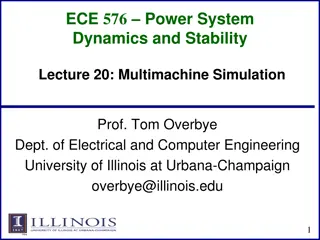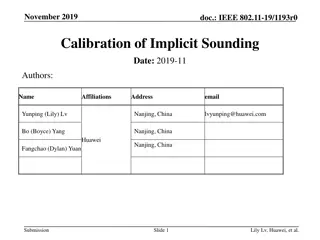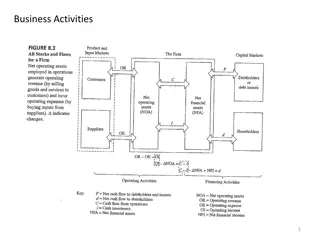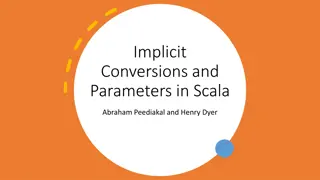Numerical Effects of Reformulated SAT with Implicit Surface Temperature Treatment
This study investigates the impacts of a reformulated SAT on the heat budget of a snow-free surface layer, particularly considering snow cover effects. The ConSAT task involves understanding the feedback between transfer velocity and surface temperature. The research aims to address issues related to large time-step increments and implement new features to ensure stable model performance without artificial flux reduction.
Download Presentation

Please find below an Image/Link to download the presentation.
The content on the website is provided AS IS for your information and personal use only. It may not be sold, licensed, or shared on other websites without obtaining consent from the author.If you encounter any issues during the download, it is possible that the publisher has removed the file from their server.
You are allowed to download the files provided on this website for personal or commercial use, subject to the condition that they are used lawfully. All files are the property of their respective owners.
The content on the website is provided AS IS for your information and personal use only. It may not be sold, licensed, or shared on other websites without obtaining consent from the author.
E N D
Presentation Transcript
Numerical effects of a reformulated SAT with an implicit treatment of surface-temperature in the heat budget for a snow-free skin layer including a possible snow cover The connecting ConSAT task: TURBTRAN <-> TERRA Feedback between transfer-velocity and surface temperature Influence of snow-treatment Matthias Raschendorfer COSMO-GM Jerusalem 2017 Matthias Raschendorfer
What is the reason of this activity? Huge impact of surface-heat budget on near surface variables steers the partition of radiation fluxes into SHF, LHF and GHF o First implementation step into ICON-TERRA of the last year development: heat budget of a rough surface (cover-layer being a an extended skin-layer): with a test-implementation into COSMO-TERRA: with a heat storage infinite thin soil skin loosely coupled to the rigid soil part of the soil Semi-transparent for radiation no transmission only for the snow free part of the grid-cell surface Necessary adaptation to long time steps with ICON: 6 min and more time-step oscillations of T_sx = T_sf | T_sn (and the related surface fluxes) o time-bombe also for COSMO- applications amplitudes up to more than 80K !! some model-crashes for ensemble-members !! o even the active artificial flux-limiter of TERRA can not prevent from crashes!! o
Method: Identification of grid-points with large time-step increments in T_sx Producing time-step series for the selected grid-points with individual settings of special parameters (quasi-SC-simulations) Implementing new features, which may cure the problem o can be reduced to almost the previous situation by parameter settings o Performing diagnostics in order to visualize the problem and the effect of implemented measures Aim: A new formulation running stable for any situation without the artificial flux-reduction in TERRA
Result of first diagnostic: Problem is mainly related to grid-points with one or more of the following properties: strong radiation forcing (tropics) o a thin (developing or vanishing) snow-cover o frozen precipitation at warm surface | liquid precipitation at frozen surface o disappearing interception-water or snow-water o fractional snow cover (particularly with dynamical sf and sn sub-tiles) o freezing or melting of soil water o Hypothesis: Initial disturbance Not smoothed out (ore even amplified) due to missing implicitness in some fundamental formulations Implication: I: Implementing the missing implicitness II: Removing unphysical disturbances
Ad I:Linear-implicitly coupled budget equations at the surface: mean cover-temp. (of lin. vert. prof.). 0 cm T T 0 = mean snow-temp. (of lin. vert. prof.) THF GHF c 0 cm sf sf c c t snf 1 snf 0 sm T T 0 = A T THF GHF c 0 sm sn sn sn sn h t sn 0 THF THF THF w w sn sf sf T bT idealized, infinite-thin S-layer T substantial, loosely coupled, semi-transparent C-layer sf sn T sn GHF GHF T bT sn sf b sf 1 ( ) so far substituted by sf T = = b b GHF T T T sf 1 sf b 1 b 1 so far only explicit and resistance of soil-half-layer not considered sn b + bT ( ) = GHF T T 2 sn sn b 1 sn b b b 1 singularity for vanishing snow-depth sx T 0 0 sx = 3 LRF 4 T u 0 sx sx ( sx = + + + + + THF PHF SRF LRF LRF LRF SHF LHF sx d u ) 0 0 = H s SHF u c 0 = + + + 0 0 sx THF SHF LHF T T sx T s p sx T u sx sx sx ( ) sx T ( ) sx T 0 0 sx = H s red sx f sat v so far only explicit contribution considered so far no budget equation for in favour of setting LHF u d q L T s T v sx sf T T = T sx sf b 1
Ad I: Resulting matrix of the extended linear system: altered All 2 + k_soil budgets are always present (even for f_sn=0 or f_sn=1) created They are linearly coupled in the temperatures: sn sf b1 b2 b3 d b sn 1 sn sn T a a isc sn sn d sf T sf sf b sf 1 a a fes sf bd bT sf b 1 1 sn b 2 1 ba1 ba ba1 ba ifb 1 1 bd bT b 1 2 b 2 2 b 1 2 ba ba ba 2 2 b 2 3 b 3 3 b 4 3 ba ba ba Can easily be tri-diagonalized by matrix-operations and solved by the standard solver Partly reducible by parameters: isc: fes: ifb: degree of corrected implicit coupling of T_sn to the soil- and atm. temperatures degree of considered flux-equilibrium in diagnostics of T_sf degree of implicitness for effective surface fluxes used in the heat budgets Default for test: isc=1; fes=1; ifb=1 (full implicit solution active) - modified for diagnostic points
Ad I: Test-grid-point Kenia (+33.71_+7.89) : After-noon situation; tropical hot with strong radiation forcing 3 hour ICON-global test-run (R2B6) with defaults of the new SAT/TERRA-scheme (dt=6 min) Emulation of so far operational surface coupling only for a special grid-pointC THF_sf T_sf old-sx-coupling: isc=0; fes=0; ifb=0 Strong 2*dt- oscillations with old coupling around noon with strong radiative forcing!
Ad I: Test-grid-point Kenia (+33.71_+7.89) : After-noon situation; tropical hot with strong radiation forcing 3 hour ICON-global test-run (R2B6) with defaults of the new SAT/TERRA-scheme (dt=6 min) Emulation of so far operational surface coupling only for the special grid-point: T_sf SHF_sf old-sx-cpl + ifb=1 old-sx-cpl + ifb=1 Oscillations strongly reduced by ifb=1 (implicit flux increments active for soil forcing)
Implicit increments of atmospheric transfer velocities: Ad I: H s u Remaining oscillations may be due to implicit T_sx-dependency on transfer velocity for heat , which is the main variable part in the linear coefficients SHF_sx and LHF_sx: ( ) sx T ( ) sx T 0 0 0 sx 0 sx = H s red sx f sat v LHF u d q L = H s SHF u c T s T v sx T s p sx sx s u s u ( s u ) 0 0 0 = + H H s H H 0 sx u : T T T sx sx T The implicit heat budgets for sf and sn become quadratic in : sx * From solutions of the decoupled versions of these quadratic equations: sx T s u s u ( s u ) * 0 0 = + H H H * 0 sx T T T sx sx This updated transfer velocity is used in the subsequent linear system: * H s u The factor of the linear T_sx-dependency of the transfer-velocity is estimated by registration: 1 g g T T s u 0 1 H s H ( ) u s u 0 = + H T : 1 sn f T f T g sf sn sn T 0 sx
Ad I: Test-grid-point Kenia (+33.71_+7.89) : After-noon situation; tropical hot with strong radiation forcing 3 hour ICON-global test-run (R2B6) with defaults of the new SAT/TERRA-scheme (dt=6 min) Non-default settings only for the special grid-point: T_sf LHF_sf old-sx-cpl + Ifb=1 + itv=1 old-sx-cpl + Ifb=1 + itv=1 Oscillations almost completely eliminated by ifb=1 + itv=1 Similar result but a bit larger daily amplitudes ifb=1 + itv=1 + fes=1 (not shown) itv=1: full consideration of implicit T_sx-dependency in atmospheric transfer velocity fes=1: full consideration of flux-equilibrium at the sf surface
Ad I +II:Scheme for snow-covered fraction and snow-depth : Snow is not equally distributed along the grid-cell surface, due to various sources of inhomogeneity: sn f Snow-covered fraction w increases monotonically with mean snow-water level of a grid cell sn c sn w until a critical mean snow-water level is reached. w = h w sn Specific snow-water-level is prop. to specific snow-depth sn f sn f 1 sn sn w sn c sn w ssp ssp w w sn sn 0 0 c sn c sn w w New control-parameter : ssp: spreading efficiency c sn w w ssp=0: ssp=1: so far operational version; not steady; it is always !! full snow-spreading; always full snow-cover!! sn
Ad I: Noth-India (+85.51_+28.33) : Evening situation; frozen soil; snow-fall with a thin snow cover yet 3 hour ICON-global test-run (R2B6) with defaults of the new SAT/TERRA-scheme (dt=6 min) Non-default settings only for the special grid-point: T_sn [C] T_sn [C] old-sx-cpl + isc=0.0 + ssp=0,2 old-sx-cpl + isc=0.0 + ssp=0,4 h_sn [mm] full-impl-cpl + isc=0.0 + ssp=0,4 full-impl-cpl + isc=1.0 + ssp=0,4
Removing various unphysical disturbances: Ad II: Various artificial limits (mainly due to the explicit formulation itself) are sources (or at least the trigger) of oscillations or are not in accordance with the implicit solution Some of them have been removed: Implicit and positive definite treatment of surface water reduction (interception water or o snow) by evaporation Quadratic equation for w_sf or w_sn adapted linear T_sx-coefficients of LHF Reduction of evaporating surface Various security limitations of w_sf | w_sn, of h_sn | f_sn, as well as for T_sf | T_sn o Water phase conversions of precipitation specific for sf and sn surface o Consideration of all the conversion heat in the thermal budgets o Adaptions in the aggregation of variables for dynamic sn and sf sub-tiles o Others are still active: o explicit treatment of snow-melting separated form the implicit heat budget explicit treatment of soil water freezing and -melting separated form the implicit heat budgets o general neglect of SHF related to precipitation and infiltration!! o
Ad II: Siberia (+102.83_+43.42) : Nocturnal cooling; partly frozen soil with fractional snow-cover with full implicit coupling: sf-surface sn-surface T_sn [C] T_sf [C]still some oscillations!! vanishing for deactivated soil-freezing!! new-def-cpl new-def-cpl + sof=F new-def-cpl new-def-cpl + sof=F sof=F: explicit soil-freezing and melting is deactivated Oscillating T_sf is due to instability in explicit formulation of soil-freezing or -melting Snow-cover is not affected
Ad II: Siberia (+102.83_+43.42) : Nocturnal cooling; partly frozen soil with fractional snow-cover with old explicit coupling: sf-surface sn-surface sof=F: explicit soil-freezing and melting is deactivated Oscillating T_sf due to instability in explicit formulation of soil-freezing or -melting T_sn is oscillating regardless if soil-freezing and melting is switched on or off
Resume: If you don t look a time-step ahead, disturbances in your relations may cause amplifying feed-back reactions!
Outlook: Including melting of snow and freezing/melting of soil-ice into the implicit heat budgets Extending the coupled heat-budget of the snow-free skin-layer by the extended one for the roughness cover Consideration of sensible heat related to water fluxes
Main new features implemented: Reformulation of the heat budget equations in TERRA for the: roughness-cover of the snow free-part (sf) | single-layer snow-cover at the snow-cov. part (sn) uppermost soil layer (b1) Implicitly coupled by temperatures: T_sf T_sn and T_b1, T_b2, Linearizing the dependency on T_sx = T_sf | T_sn for all contributing surface fluxes Additional implicitness by considering the T_sx-dependency of atmospheric transfer velocity Implicit increment transfer velocity is quadratic in T_sx Snow heat budget reduces -> skin-layer flux-equilibrium in the limit h_sn -> 0 New steady and more realistic parameterization of snow-fraction as a function of snow-water Describing phase change of falling precipitation more consistently Implicit treatment of surface water levels (w_sf | w_sn) with respect to evaporation
WG3a-Activities and PT ConSAT: Review of verification with common blocked TURBDIFF and old TERRA in COSMO-DE Verification of the EDP-forecast derived from TURBDIFF within the ICON model Towards a new diagnostic of equilibrium surface temperature in combination with SAT and the soil model Feedback between transfer-velocity and surface temperature Applicability of a tile approach in cases with stable stratification Matthias Raschendorfer COSMO-GM Jerusalem 2017 Matthias Raschendorfer
